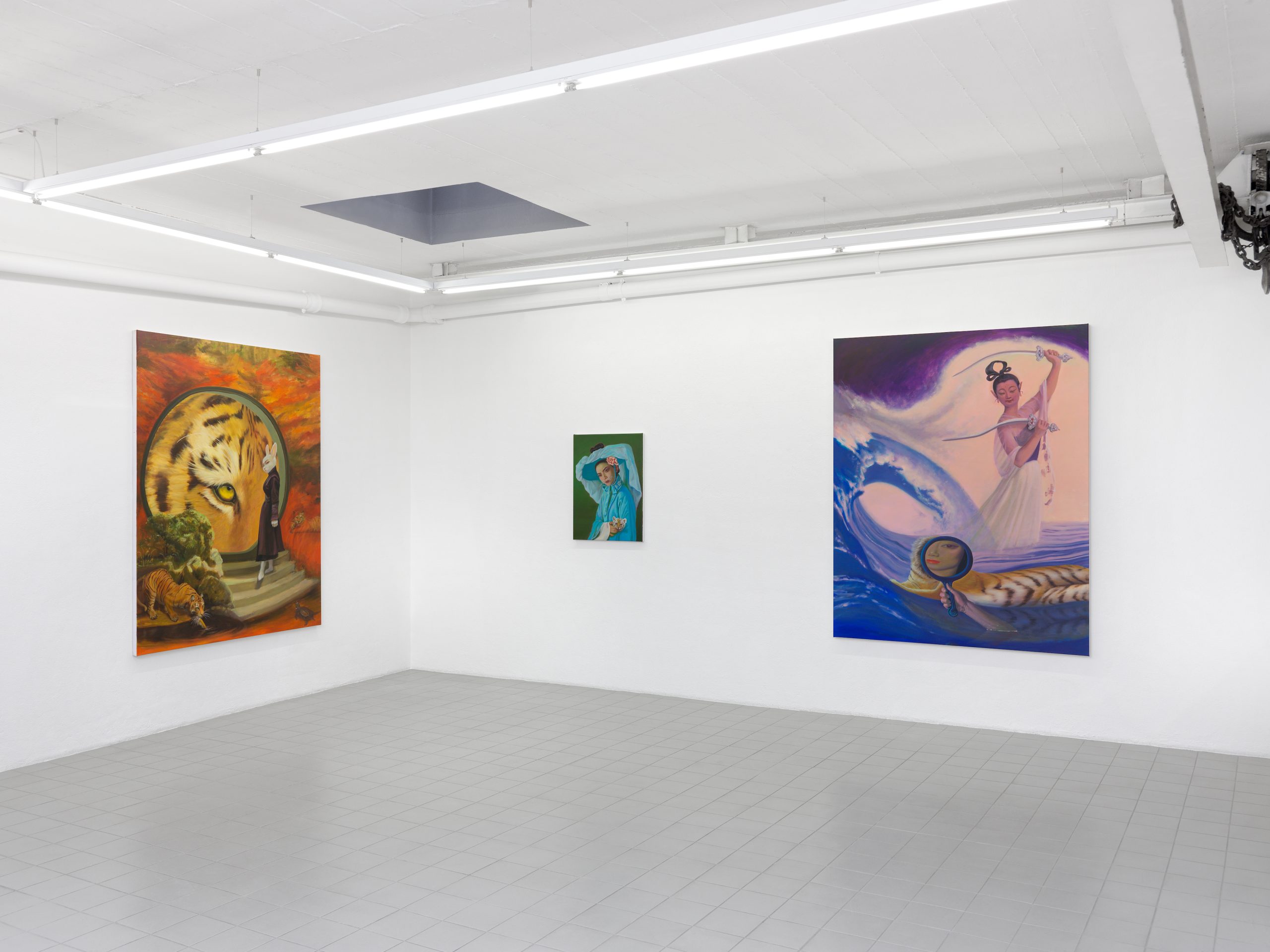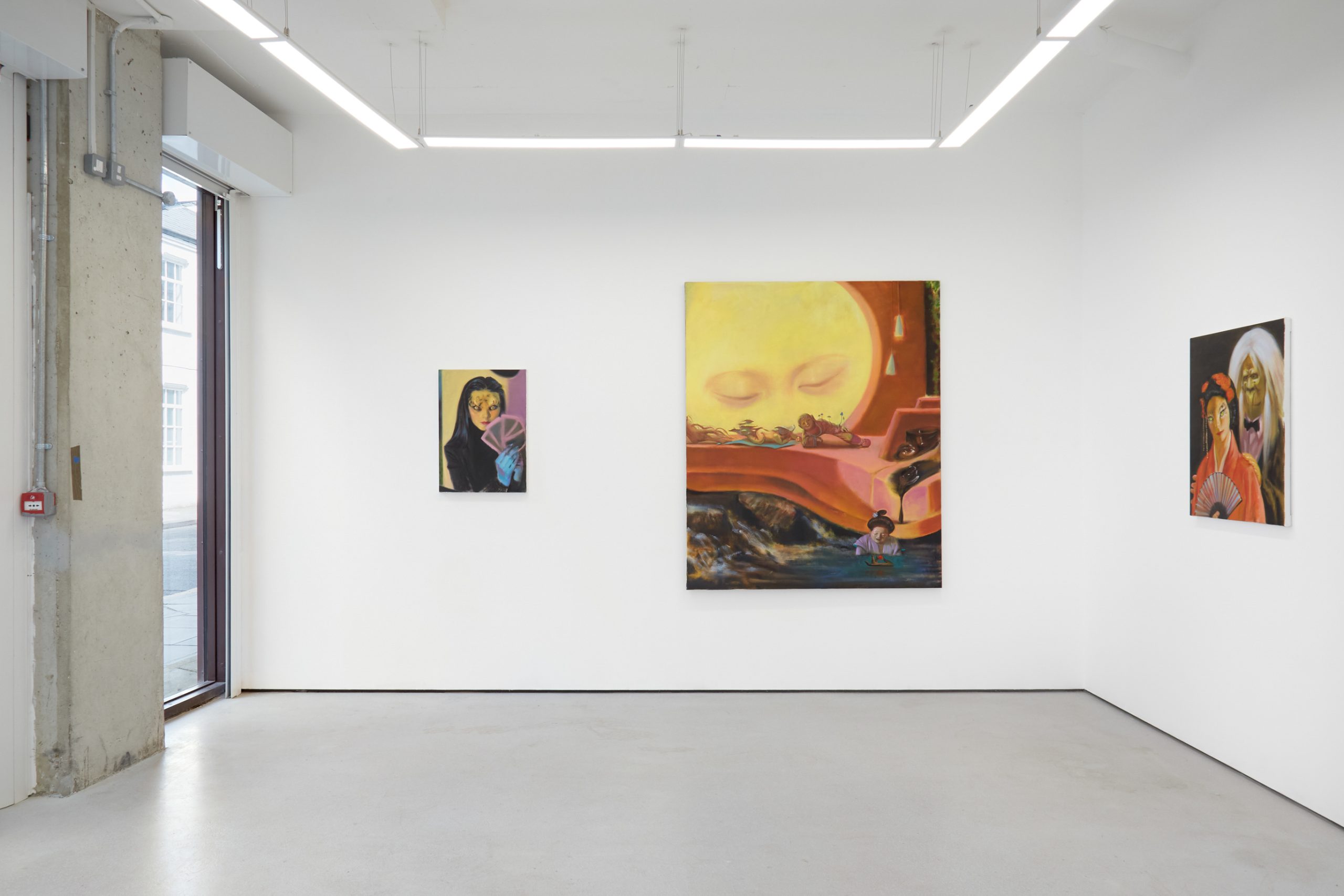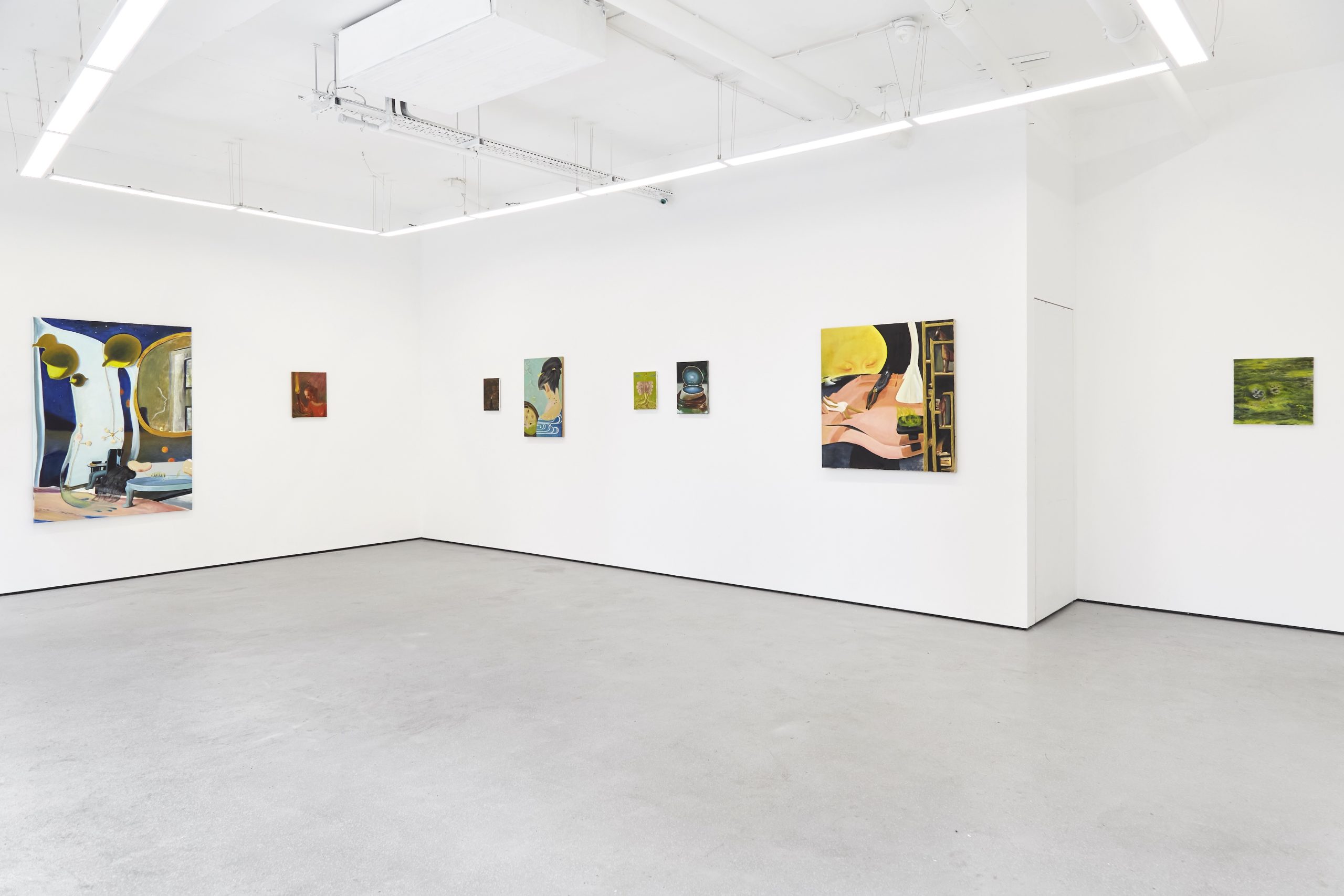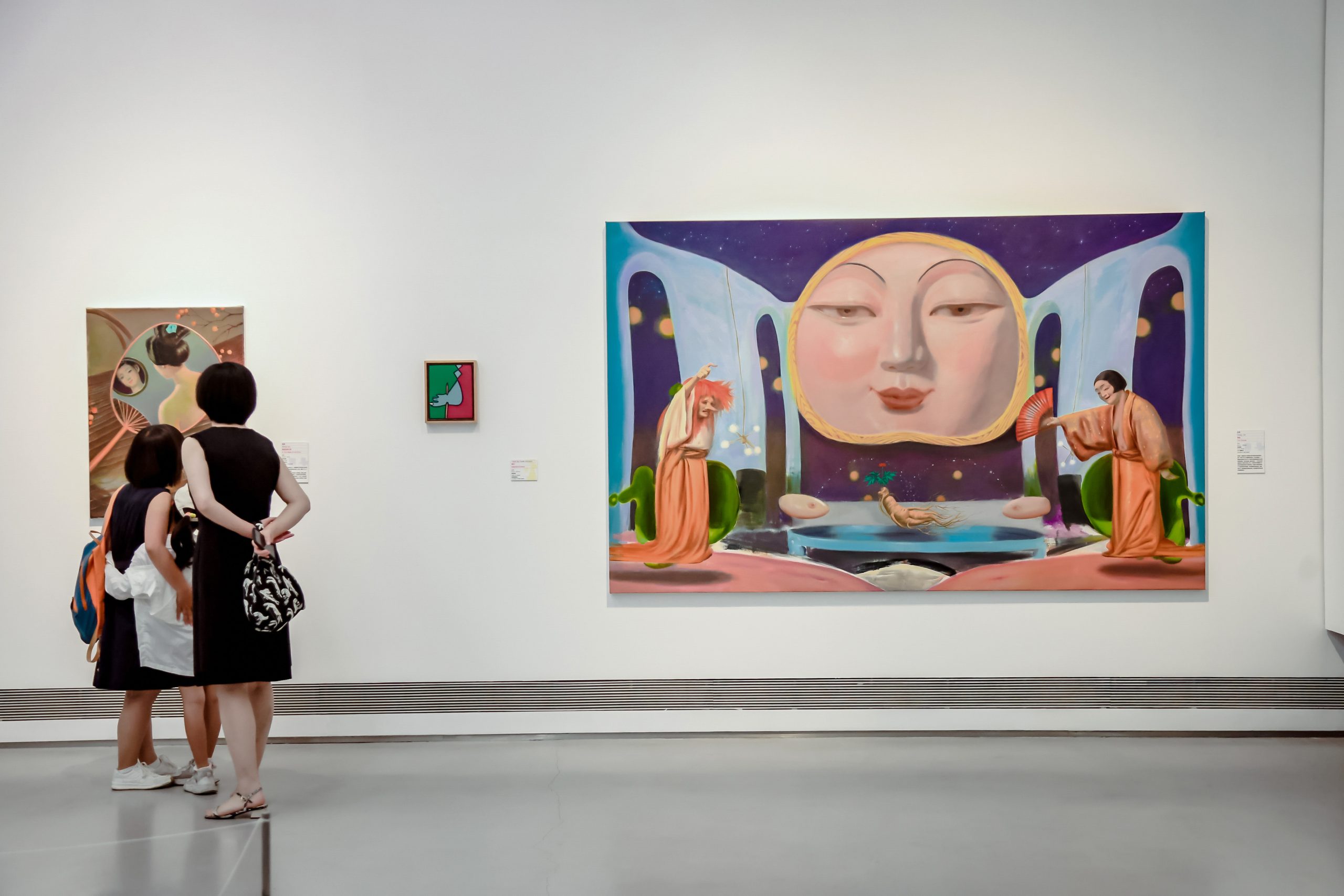Solo Exhibitions

The Rabbit Who Hunts Tigers, Geneva Switzerland, 2023.
Sebastien Bertrand are pleased to present The Rabbit Who Hunts Tigers the first solo show of the artist Lian Zhang (1984, Hangzhou) at the gallery.
Zhang creates powerful, emotional landscapes that transport the viewer to another time and place. Her nostalgic, illusory scenes incorporate autobiographical fragments alongside references to Eastern and Western mythology, folklore, art, history, and popular culture. Each composition dwells on contradictions that blend past and future, good and evil, myth and reality, tragedy and comedy, and hints at multifaceted narratives that strain in many different directions at once. Her works draw from Surrealism, Symbolism, Taoist philosophy, and her personal experience living in London as an immigrant.
Executed with a vivid color palette and filled with the energy of both stasis and motion, her paintings embody a fluidity between objects and figures. Zhang aspires to achieve a form of soft power via delicate, flowing, water-like brushstrokes that interlace disparate elements across the surface of the canvas.
“I always imagine that my hands become water; they travel freely when moving here to there in a painting.” – Lian Zhang
Water – formless, shapeless, and adaptable – is an important component of Zhang’s work and a great source of inspiration. In that regard, she refers to Bruce Lee’s metaphor about water, quoted in Yin Yin’s album The Rabbit that Hunts Tigers, which gives its title to the exhibition.
While many of Zhang’s previous paintings were about exploring the experience of living abroad, this new body of works is about returning to an estranged homeland and confronting one’s deepest fear by ripping off the old wounds. They are based on the idea that life is impermanent, but one should never stop battling with inner demons and fight for a better future. The exhibition features ten paintings, three of which are large-scale atmospheric, dreamlike scenes. The other seven are uncanny portraits of female hybrid characters defying the viewer with their intense gaze.
The large work Tiger’s Den challenges the conventional storyline of predators and preys and reminds us that those presented as the perfect embodiment of strength and evil are, first and foremost, animals. Indeed, the demons we are afraid to face are always inside us. We are also reminded of this through All of our waves are water that depicts a tidal viewing ceremony of the Qian Tang River, which the artist could witness from her balcony.
“My studio was on the 24th floor, I saw so many tiny humans standing on the shore the whole afternoon just to see the waves which pulled by the gravitation of the moon goddess.” – Lian Zhang.
This piece takes this event further, to when everything gets out of control and the moon goddess stands on the water and fights her way out by cutting waves with her warping swords to kill the beast that blocks her way.
The Invasion, semi-autobiographical in a surrealist way, depicts a time when both the inner life and outer world are floating, leading to a plot that repeatedly happens in a distorted, dreamlike labyrinth inspired by reality.
Her ongoing series of female portraits explores Asian female identity, while highlighting and undermining some of the ways in which Asian women are stereotyped and objectified. Ambush is based on Anna May Wong, the first Chinese American actress to gain international recognition, but is yet mostly remembered for her stereotypical supporting roles as “Dragon Lady”. Huntress, Bystander, Tropical Sun and The Silent One are inspired by vintage posters in which the main protagonists were objects of male gaze. By giving these models a peculiar twist, Zhang makes them gaze back at the viewer with their monster eyes and unconventional expressions. Cry of a Friend and The Archer explore the symbol of rebellion and satisfy our thirst for freedom.
I said empty your mind
Be formless
Shapeless
Like water
Have you put water into a cup?
It becomes the cup
You put water into a bottle, it becomes the bottle
You put it in a teapot, it becomes the teapot
Now water can flow or it can crash
Be water, my friend
– Bruce Lee quoted by Yin Yin, in “One Inch Punch” – The Rabbit That Hunts Tigers, 2019

Fast Dreams, Slow Days, LA USA, 2022.
Lian Zhang: Fast Dreams, Slow Days is the artist’s first exhibition with Nicodim. Zhang’s works hint at multifaceted narratives that strain from multiple directions simultaneously. Each composition is a theater of contradictions that blend past and future, good and evil, myth and reality, tragedy and comedy, interweaving allusions to historical moments and classical forms from Zhang’s Eastern and Western heritage. Investigating the connections between interior and exterior worlds, she constructs scenes from both personal memories and imagined landscapes wherein figures and objects operate fluidly between stasis and motion. Set within rich art historical tradition, Zhang’s works draw from Surrealism, Symbolism, Taoist philosophy, and her personal experience living in London as an immigrant. Challenging preconceptions through painterly narratives, the artist’s work negotiates a space for her own intersecting cultural identities.
Within Fast Dreams, Slow Days, gods, fairies, demons, humans, plants, and animals morph into and repel against one another. In Forever and Ever (2022), a half goat/half human figure holds court beside a circular mirror-portal into a traditional Chinese garden. Resembling the Greek god Pan (god of poetry, music, and love) the figure’s sly smile implies a sinister edge, where creation and dreams teeter on destruction and horror. An auspicious symbol in Taoist tradition, the gourd in his hand is a container that holds the elixir of life, a magical substance produced through Chinese alchemy. The gourd and the god are both capable of unlocking everlasting power, but can also be weaponized for destruction.
Her piece Windy Paradise (2022) questions and confronts the socio-political dynamics of the United Kingdom, her second homeland. The work encapsulates the beauty and strangeness of establishing a new home where she has built her family and career by her own hand. Also inspired by the Yu Xiuhua poem “Wind Blow,” Zhang’s painting acts as a visual homage to the text. The poem discusses the life cycle of a morning glory, whose petals open and close depending on the time of day. Zhang’s mother and daughter figures, skirts swept up by a gust of wind panging English seaside cliffs, mirror Xiuhua’s gentle blue morning glories, their vines climbing upwards, forever reaching for something on which to hold.

Weathering with you, London, 2022.
Lychee One proudly presents Weathering with You, a solo exhibition of new work by London-based Chinese artist Lian Zhang. The exhibition is curated by Marcelle Joseph with the exhibition text below written by Gabriella Pounds.
‘Fucking you and being fucked by you are quite the same,’ opens Crossing Half of China to Fuck You, a poem by Yu Xiuhua. [1]In 2014, a Chinese literary magazine published the poem on the messaging app WeChat, attracting a million shares. Xiuhua’s verse floats in the undertow between beauty and violence. There are images of political prisoners, infra-red-eyed deer, rain composed of silver bullets, a virtual spring. Bodies being disgusting. After the poem went viral, Internet users condemned it as ‘slut poetry’. Xiuhua responded: ‘So what if I am a slut?’
Xiuhua’s punkish sensibility respawns throughout Lian Zhang’s paintings. In Reincarnation (2022), a severed nude lies in a steel blue lake. A butterfly rests its wings on her pink nipple. Above her, a planet mixes with an eyeball. If Xiuhua’s poems explore infinite desire, then Zhang’s paintings sync a lover’s iris with nebulae.
Cosmos. Oceans of time and space. On principle, the Surrealists loved it. Zhang, however, belongs to the Surrealist tradition outside of Western history. At Night (2022) depicts a figure immersed in waves of blue paint. She wears an angular, quiet-coloured shirt like an ancient envelope. A feminine-faced-disk inflames the ravine. And recalls poet and post-colonial philosopher Aimé Césaire in Solar Throat Slashed (1948): ‘the sun is a raped girl’ of ‘polarized light’. [2]For Césaire, fire is not a destructive image. It is a ‘cosmic anger’ of the marginalised. [3] It vomits forth a maimed life.
Zhang’s brushstrokes are like manga moths circling a flame. In Future (2022), a figure emerges from whirlpools of navy and lily-white paint. A cute plant grows from her hair caught in the teeth of the wind. She colours a 1960s home with a fluorescent green fingertip. While her outfit recalls medieval China, the atmosphere feels all the assassination of U.S. President J. F. K., petal-shaped sunglasses, and space oddity. In Dealer (2022), meanwhile, blades of paint simulate a turtle-necked protagonist. She appears equal parts gamer Susan Sontag and a baby fox.
Weathering with You (2019) refers to Makoto Shinkai’s animation film. It imagines a dystopian Tokyo amid silent rain. The character Hina, however, can manipulate the weather and invoke drifting cherry petals, sunshine. Like Makoto Shinkai, Yu Xiuhua and Aimé Césaire, Zhang shares an apocalyptic, surgical approach to art in the service of a brighter future.
[1] From Yu Xiuhua, Crossing Half of China to Fuck You, in ‘Moonlight Rests On My Left Arm’ (2021), p.1.
[2] From Aimé Césaire, Secret Society, in ‘Solar Throat Slashed’ (1948), p.19.
[3] Annick Thebia Melsan, An Interview with Poet Aimé Césaire, Journal of Pan African Studies, vol.2. no.4, June 2008, p.6.
Text by Gabriella Pounds

Constellation and Folds, London, 2020.
Lychee One proudly presents Constellations and Folds, Lian Zhang’s first solo exhibition with the gallery.
Rather than being introduced into a leaden sense of suspended time, we are instead invited to roam through a lost or yet to come labyrinth of temporalities. The dominate mood circulates around various modes of enchantment, as opposed to anxieties born out of late time. Attached to this circulation are registers related to virtual, childhood, mythic, and mystical spaces that all float free from the weight historical exactness. Following from this the tone of the paintings are light in ways that induce sensations related to reverie or imaginative drifting.
These paintings are born out of the last three months of ‘lock down’ in which other resources of living and absorption have to be invented. A counterintuitive response has been formed within this contraction of social space, a response that invites a multiplicity of optical attachments that pass over, through and before. All of this occurs without the process of objectification or fixed modes of identification manifesting as a constellation of images as opposed to a serialised progression.
Part of this difference between constellation and serialised progression is, or can be viewed as a relationship between fragmentation and detachment becoming re-inscribed into metamorphic patterns of becomings born out a belief in the world being composed out of a single substance. In this world all elements appear to reconnect with dispute realms in a series of fresh encounters mixing the realms of the vegetal, animal, insect, human, objects, elements, and gestures. Within this, there are the circulation of moods connected to the play of absorption and fascination in which detachment and abstract measure are abolished. The paintings themselves are sensual, even fleshy, inviting a touch-feel relationship as a way of being-with as surface encounter.
In many ways this marks a turning away from earlier work with its pre-occupations with the detached fragment, image appropriation, visual arrest, collage and layering. This indicates quite another perspective not only in regard to painting but more fundamentally the world in its passage from one schema to another. The question which is being posed within this shift relates to how the artist might make manifest this moment of both temporal register and schematic reconfiguration. Being thrown to the wind and finding a place within a remote order of things is to follow a gesture, a mode of gesture that finds its coherence within the multiplicity of folds of temporality and the image。
Text by Jonathan Miles
Group Exhibitions
